An impressive city at the Danube river

This is the striking west fašade of St Peter's Cathedral (July 2007). Constant renewal works are necessary because of the slight weathering of the green sandstone, but also because of the environmental pollution. For this purpose, the Free State of Bavaria maintains its own cathedral building hut in the Cathedral Garden. The last major renovation was completed in time for the Pope's visit in 2006.
The west fašade dates from the 15th century and is mainly the work of master builders from the Roritzer family. Due to the centuries of construction, the gothic style has changed. The cathedral construction was stopped in 1525.
The pointed towers were not erected until 1859-1869 on the initiative of King Ludwig I of Bavaria (height 105 m). The cathedral construction was started in limestone, later
continued with green sandstone.
From the Romanesque predecessor of the Gothic cathedral the donkey tower and in the foundations of the chapter house remains of the former northern side aisle are preserved. Parts
of the Romanesque paradise (porch) can be visited in the so-called bishop's tomb.
In the 2nd half of the 13th century the construction of the new cathedral was started. For 1276 an altar consecration is handed down. At the end of the 13th century the building, which was erected in the spirit of French Gothic, was about half finished.
The cathedral, which was furnished in the 18th century in baroque style, was radically regotised in the 30s of the 19th century. Only the Early Classicist high altar made of
silver and gilded copper from 1695-1785 and the high grave for Cardinal and Bishop Philipp Wilhelm of Bavaria in the central nave remained in the cathedral. The medieval windows
inside the cathedral are impressive.
To the north of the cathedral chapter house is the cathedral cloister with vaults from the 15th century and windows from the Renaissance around 1515.
On my bicycle tour from Donaueschingen to Vienna I took up quarters in the middle of the old town. The old town is full of life and exerts a very special charm. Once again, the
bicycle proved itself for a city tour and I was enchanted by the Romanesque and Gothic architecture of the Middle Ages.
Something special are the gender towers of Regensburg. Similar to the Italian St. Gimignano, the stone-rich Regensburg merchants built towers on their houses. The richer they were, the higher the towers were. They were used as storage rooms.
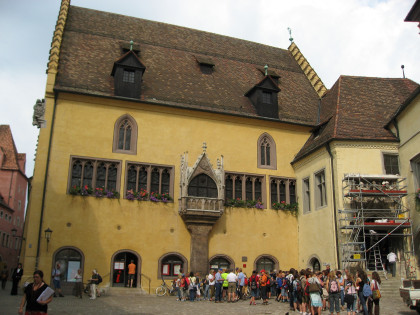
The old town hall is a magnificent patrician castle with a tower. In the first half of the 14th century, the city lords had the great ballroom rebuilt to the west, the fašade of which is decorated with the carefully worked "Reichssaal-Erker".
As early as the Middle Ages, this hall was used on various occasions as a conference venue for imperial diets, i.e. for assemblies of all the imperial estates (electors, princes and imperial cities) convened at irregular intervals by the emperor at changing locations.
From 1594 onwards, the powerful of the Holy Roman Empire of the German Nation met exclusively here.
The Tourist Information is located in the basement of the Reichstag building. Groups gather here for various guided tours. Photo: July 2007

From 1663 the Reichstag met permanently in Regensburg. The princes were represented by their envoys.
The Emperor was bound to the Reichstag in all important matters, including tax matters.
Only with the end of the Holy Roman Empire of the German Nation in 1806 did the "everlasting Reichstag" end in Regensburg.
During these 143 years it developed into a flexible instrument that helped to solve conflicts between the countries and territories of the Empire.
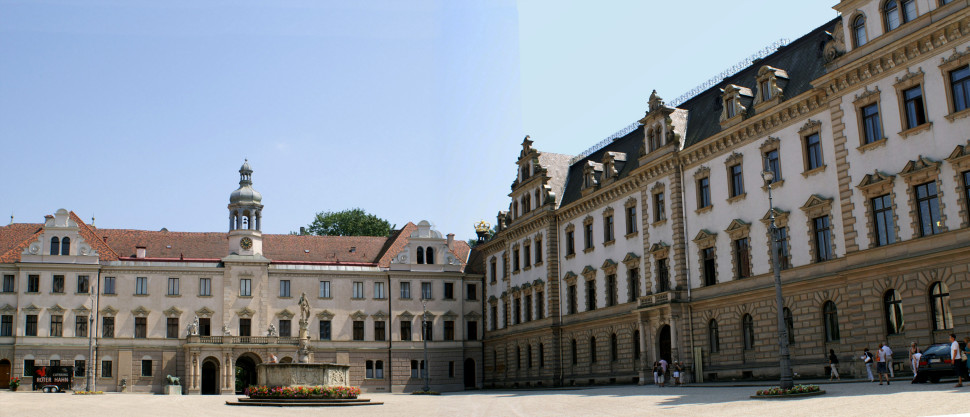
Since 1812, the former monastery complex of St. Emmeram with its newly built south wing in the 19th century has been the permanent residence of the princely family Thurn und Taxis and thus one of the largest inhabited castles in Europe. A history of more than 250 years connects the city of Regensburg and the princely family Thurn und Taxis until today. The prince was granted the special honour of representing the emperor at the "everlasting Reichstag".

The cloister of the former monastery St. Emmeran.

Over the Stone Bridge, which is also part of the Way of St. James, the way led me out of the city again to the Danube cycle path further towards Vienna.
Already Charlemagne had a wooden bridge built about 100 meters downstream. But this bridge has been destroyed again and again by the flood. Under the reign of Henry the Proud
the construction of the 'Stone Bridge' was started in 1135.
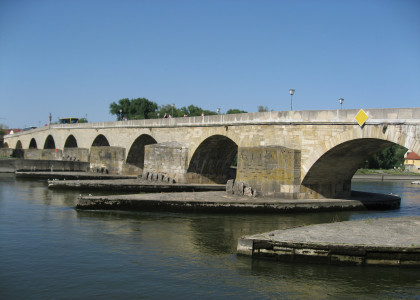
The construction of the bridge is said to have taken 11 years. Originally, the bridge spanned the Danube with 16 round arches on 15 pillars and had three towers. The medieval building miracle became the model for many bridge constructions, such as the Charles Bridge in Prague.
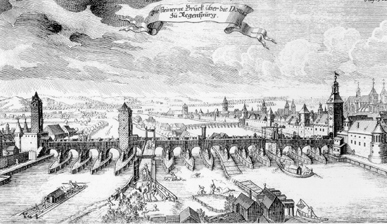
Picture of the original bridge. It is a pity that the middle and the left tower have not been preserved. In Cahors there is still a romanesque bridge with all the towers.

The former Monastery church St. Jakob in Regensburg was built in the 11th century by Irish Benedictine monks den Skoten. It is one of the major works of Romanesque architecture in southern Germany.
From here another Scottish monastery was founded in 1135 in WŘrzburg - today Don Bosco Church - and one in Erfurt in 1136.
The Babenberg duke Heinrich II. Jasomirgott brought the 'Scotsmen' to Vienna in 1155 and founded the
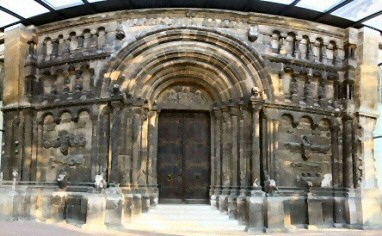
The famous north portal of St. Jacques, known as "Schottenportal", is one of the most important Romanesque architectural monuments in Germany.


Danube cycle route

In search of Gertrud:
Gertrud of Supplinburg was here in Regensburg with her husband, Heinrich the Proud, Duke of Bavaria and Saxony.
She was also here with her second husband Heinrich Jasomirgott. As Duke of Bavaria he also had his seat of government here.
Is Gertrud maybe buried in Regensburg in the St. Jacques Church (Schottenkirche) or in the St. Ulrich Church (Pfalzkirche)?






